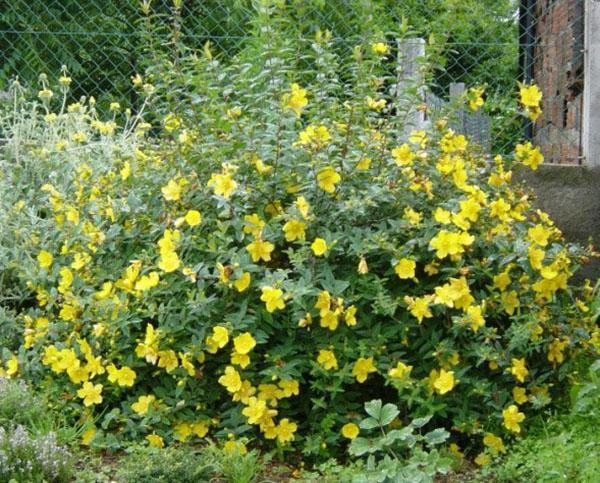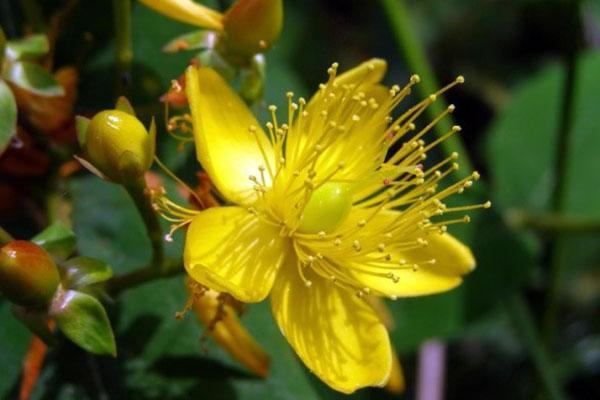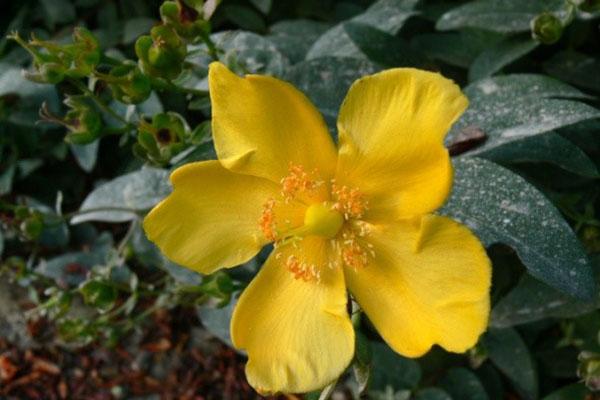Rules for growing St. John's wort and competent care for him
 St. John's wort, unlike its wild relative, does not possess medicinal properties. Among gardeners, it is valued for its decorative effect. Its large spherical bushes become a spectacular decoration of any personal plot. In order for the plant to have a spectacular appearance, it must be properly looked after.
St. John's wort, unlike its wild relative, does not possess medicinal properties. Among gardeners, it is valued for its decorative effect. Its large spherical bushes become a spectacular decoration of any personal plot. In order for the plant to have a spectacular appearance, it must be properly looked after.
The best varieties
To date, science knows more than 300 species of St. John's wort. On summer cottages, you can find only a few varieties:
- Spreading. This species is popular in Southeast Asia. The height of one bush reaches a meter. The leaves have a regular ovoid shape, up to 5 cm in length. Bright yellow flowers are decorated with numerous large stamens. Flowering continues for two months.

- Hooker. The height of a spherical shrub can reach one and a half meters. During flowering, it becomes covered with flowers, the diameter of which reaches 6 cm. They are painted in bright yellow. Due to the large number of small stamens, the middle of the flower looks fluffy. Only a plant that has reached the age of three years can bloom. It does not tolerate the cold well, so it should be better sheltered for the winter.

- Two-fraternal. It is widely distributed in the Caucasus and Western Europe. The shrub of St. John's wort of this variety grows up to one and a half meters in height. Flowering begins in mid-June and lasts for a month. After three years, fruits appear on the plant. They have a decorative appearance.

- Brigadoon. A distinctive feature of this variety is the shiny elongated leaves of a yellow-green color. Small golden flowers cover the shrub in early spring. The height of the bush rarely exceeds 30 cm. Prefers sunny areas with light drained soil.

- Calyx. It is considered the most unpretentious variety. It does not exceed 30 cm in height. During the flowering period it is covered with large flowers up to 7 cm in diameter. Flowering continues throughout the summer.

St. John's wort can be used as a hedge. Its large shrubs will reliably protect from prying eyes. The main thing is to follow the simple rules for caring for the plant.
For summer cottages, it is better to choose a cup St. John's wort. It is unpretentious and does not require special care. It can be planted on slopes to strengthen the soil.
Landing rules
 Planting and caring for St. John's wort does not require special skills. Even an inexperienced florist can cope with this. The plant reproduces well with cuttings. During landing, you must follow a certain sequence of actions:
Planting and caring for St. John's wort does not require special skills. Even an inexperienced florist can cope with this. The plant reproduces well with cuttings. During landing, you must follow a certain sequence of actions:
- Purchased or cut cuttings should be placed in clean warm water for two weeks. During this time, roots should form on them.
- Petioles with root systems are transplanted into small pots filled with soil. Make up a soil of sand and peat, taken in identical proportions.
- In this state, subject to regular watering, the cuttings should spend the whole winter.
- Plants can be planted outdoors in spring. To do this, they dig a small hole, at the bottom of which a layer of humus is poured.
- You should not bury the cutting deeply. It is enough to close the root system. Tamp the ground well and sprinkle with warm water.
If planting and caring for shrub St. John's wort is carried out correctly, then flowers will appear in the very first year. In order for them to winter normally, they must be covered with a nonwoven material, for example, spunbond.
Basic care guidelines
 St. John's wort is an unpretentious plant. Caring for him consists in regular watering and weeding. In springtime, you can feed him mineral fertilizers... Responds well to the introduction of nitrophoska in the first two years of growth.
St. John's wort is an unpretentious plant. Caring for him consists in regular watering and weeding. In springtime, you can feed him mineral fertilizers... Responds well to the introduction of nitrophoska in the first two years of growth.
Before wintering, the plant must be pruned. The entire aerial part is removed. The remaining necks are covered. For this, non-woven material, fallen leaves or dry grass are used.
As St. John's wort grows, it is necessary to remove dry leaves from it and cut off damaged branches. In rare cases, dark spots are found on the leaves. This indicates the defeat of the rust fungus. The affected leaves are cut off and certainly burned. Even with good care, after three to five years, the plant loses its decorative effect, so the planting needs to be updated.
St. John's wort is an ornamental shrub with excellent decorative properties. It looks great on slopes or near a fence. With proper care, it will delight you with rapid flowering.